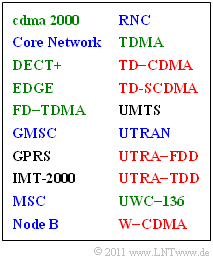Difference between revisions of "Aufgaben:Exercise 3.6Z: Concepts of 3G Mobile Communications Systems"
| Line 32: | Line 32: | ||
<quiz display=simple> | <quiz display=simple> | ||
| − | |||
{Which of the following statements are correct? | {Which of the following statements are correct? | ||
| Line 73: | Line 72: | ||
'''(1)''' Correct is the <u>solution 2</u>: | '''(1)''' Correct is the <u>solution 2</u>: | ||
| − | *The IMT-2000 standard includes in a first level "W-CDMA", "TD-CDMA", | + | *The IMT-2000 standard includes in a first level "W-CDMA", "TD-CDMA", "TDMA" and "FD-TDMA", <br>where only the first two mentioned variants are simultaneously attributed to the UMTS standard. |
*From this follows: UMTS is a subset of IMT-2000, not vice versa. | *From this follows: UMTS is a subset of IMT-2000, not vice versa. | ||
| Line 86: | Line 85: | ||
*Added to $\rm TD-CDMA$ are: | *Added to $\rm TD-CDMA$ are: | ||
# "UTRA-TDD", the TDD component of UMTS, | # "UTRA-TDD", the TDD component of UMTS, | ||
| − | # the Chinese "TD-SCDMA", now integrated into the UMTS TDD standard. | + | # the Chinese "TD-SCDMA", now integrated into the UMTS-TDD standard. |
| Line 92: | Line 91: | ||
The three system variants that belong to IMT-2000 but not to UMTS are: | The three system variants that belong to IMT-2000 but not to UMTS are: | ||
| − | *$\rm TDMA$: This includes further developments of the GSM offshoot | + | *$\rm TDMA$: This includes further developments of the GSM offshoot "EDGE" and its American counterpart "UWC-136", |
| − | *$\rm FD-TDMA$, the further development of the cordless telephony standard | + | *$\rm FD-TDMA$, the further development of the cordless telephony standard "DECT"', |
*the American standard $\rm cdma $. | *the American standard $\rm cdma $. | ||
| Line 102: | Line 101: | ||
'''(5)''' From the above link it also appears that <u>answers 2, 3 and 5</u> apply here. | '''(5)''' From the above link it also appears that <u>answers 2, 3 and 5</u> apply here. | ||
| + | |||
| + | '''By the way:''' <br>The only term in the graphic on the information page that does not refer to UMTS is "GPRS" ⇒ [[Mobile_Communications/Characteristics_of_GSM#GSM_extensions|"General Packet Radio Service"]] is a GSM extension. | ||
| − | |||
| − | |||
[[Category:Exercises for Mobile Communications|^3.4 Characteristics of UMTS^]] | [[Category:Exercises for Mobile Communications|^3.4 Characteristics of UMTS^]] | ||
Revision as of 17:54, 24 February 2021
On the right there are various terms used in 3G mobile communications systems.
Third generation systems include, for example, the following standards:
- $\text{IMT–2000}$: This abbreviation stands for $\rm I\hspace{-0.01cm}$nternational $\hspace{0.05cm}\rm M\hspace{-0.01cm}$obile $\hspace{0.05cm}\rm T\hspace{-0.01cm}$elecommunications at the year $2000$;
- $\text{UMTS}$: $\rm U\hspace{-0.01cm}$niversal $\rm M\hspace{-0.01cm}$obile $\rm T\hspace{-0.03cm}$elecommunication $\rm S\hspace{-0.01cm}$ystem.
Only one of the twenty listed terms is out of the ordinary. This is a system extension of $\rm GSM$.
Notes:
- This task refers to the chapter Characteristics of UMTS.
- Reference is also made to the main chapter UMTS of the book "Examples of Communication Systems".
Questionnaire
Solution
(1) Correct is the solution 2:
- The IMT-2000 standard includes in a first level "W-CDMA", "TD-CDMA", "TDMA" and "FD-TDMA",
where only the first two mentioned variants are simultaneously attributed to the UMTS standard. - From this follows: UMTS is a subset of IMT-2000, not vice versa.
(2) All entries belonging to UMTS are marked in red in the table ⇒ Answer 1:
- $\rm W-CDMA$ includes
- "UTRA-FDD", the FDD component of the European UMTS standard,
- the American "cdma 2000 system", which, however, does not belong to UMTS.
- Added to $\rm TD-CDMA$ are:
- "UTRA-TDD", the TDD component of UMTS,
- the Chinese "TD-SCDMA", now integrated into the UMTS-TDD standard.
(3) Correct is the solution 2:
The three system variants that belong to IMT-2000 but not to UMTS are:
- $\rm TDMA$: This includes further developments of the GSM offshoot "EDGE" and its American counterpart "UWC-136",
- $\rm FD-TDMA$, the further development of the cordless telephony standard "DECT"',
- the American standard $\rm cdma $.
(4) Correct are answers 1, 4 and 6, as you can read in the book "Examples of Communication Systems" in chapter UMTS Network Architecture.
(5) From the above link it also appears that answers 2, 3 and 5 apply here.
By the way:
The only term in the graphic on the information page that does not refer to UMTS is "GPRS" ⇒ "General Packet Radio Service" is a GSM extension.
